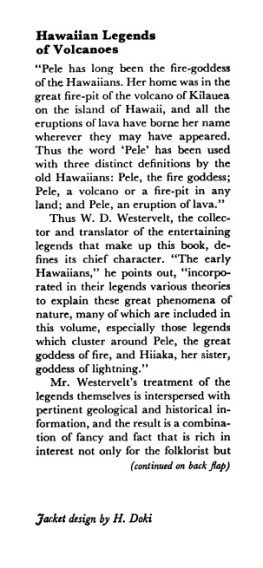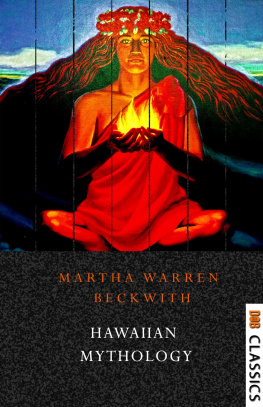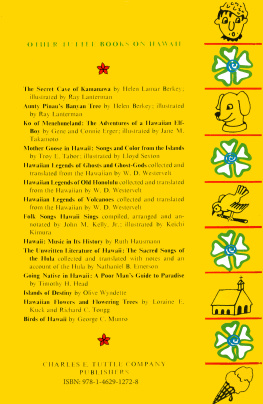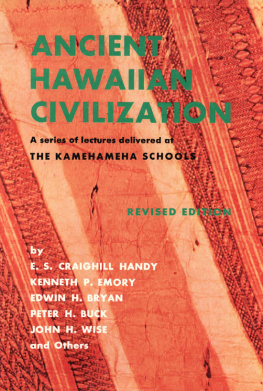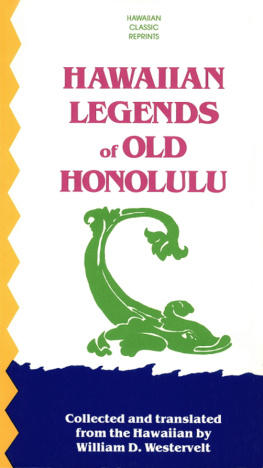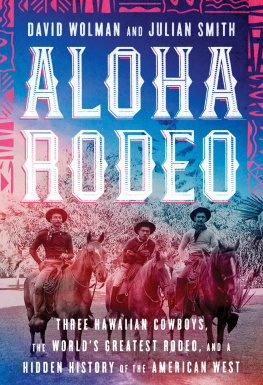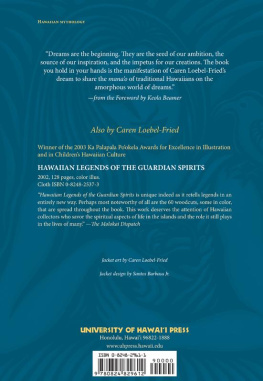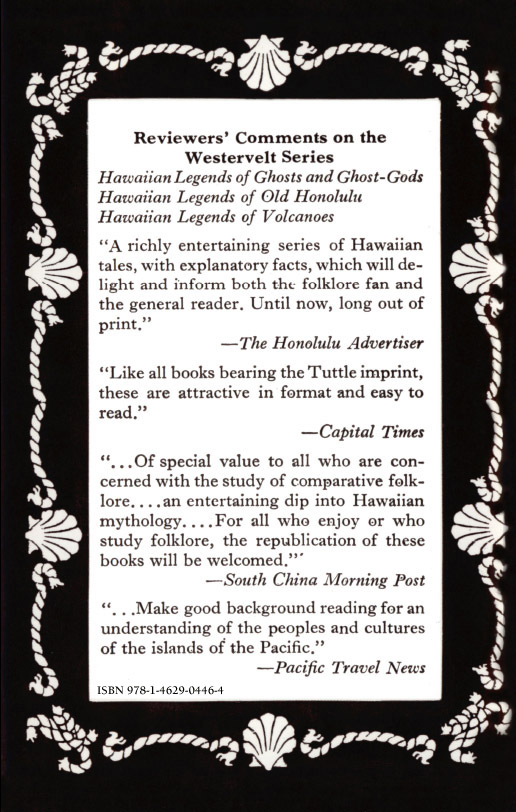Published by the Charles E. Tuttle Company, Inc.
of Rutland, Vermont & Tokyo, Japan
with editorial offices at
Osaki Shinagawa-ku, Tokyo 141-0032
Copyright in Japan, 1963, by Charles E. Tuttle Co., Inc.
All rights reserved
Library of Congress Catalog Card No. 63-22542
International Standard Book No. 978-1-4629-0446-4 (ebook)
First printing, 1963
Eighteenth printing, 1990
PRINTED IN JAPAN
POLYNESIAN LANGUAGE

"A few words should be added on the peculiar genius and structure of the Polynesian language in general and of the Hawaiian dialect in particular.
It is the law of all Polynesian languages that every word and syllable must end in a vowel, so that no two consonants are ever heard without a vowel sound between them.
Most of the radical words are dissyllables, and the accent is generally on the penult. The Polynesian ear is as nice in marking the slightest variations in vowel sound as it is dull in distinguishing consonants.
The vocabulary of the Hawaiian is probably richer than that of most other Polynesian tongues. Its child-like and primitive character is shown by the absence of abstract words and general terms.
As has been well observed by M. Gaussin, there are three classes of words, corresponding to as many different stages of language: first, those that express sensations; second, images; third, abstract ideas.
Not only are names wanting for the more general abstractions, such as space, nature, fate, etc., but there are very few generic terms. For example there is no generic term for animal, expressing the whole class of living creatures or for insects or for colors. At the same time it abounds in specific names and in nice distinctions.
So in the Hawaiian everything that relates to their everyday life or to the natural objects with which they are conversant is expressed with a vivacity, a minuteness and nicety of coloring which cannot be reproduced in a foreign tongue. Thus the Hawaiian was very rich in terms for every variety of cloud. It has names for every species of plant on the mountains or fish in the sea, and is peculiarly copious in terms relating to the ocean, the surf and waves.
For whatever belonged to their religions, their handicrafts or their amusements, their vocabulary was most copious and minute. Almost every stick in a native house had its appropriate name. Hence it abounds in synonyms which are such only in appearance, i.e., "to be broken" as a stick is 'haki,' as a string is 'moku,' as a dish 'naha,' as a wall 'hina.'
Besides the language of every-day life, there was a style appropriate to oratory and another to religion and poetry.
The above-mentioned characteristics make it a pictorial and expressive language. It still has the freshness of childhood. Its words are pictures rather than colorless and abstract symbols of ideas, and are redolent of the mountain, the forest and the surf.
However it has been and is successfully used to express the abstractions of mathematics, of English law, and of theology."
"The Hawaiian is but a dialect of the great Polynesian language, which is spoken with extraordinary uniformity over all the numerous islands of the Pacific Ocean between New Zealand and Hawaii. Again, the Polynesian language is but one member-of that wide-spread family of languages, known as the Malayo-Polynesian or Oceanic family, which extends from Madagascar to the Hawaiian Islands and from New Zealand to Formosa. The Hawaiian dialect is peculiarly interesting to the philologist from its isolated position, being the most remote of the family from its primeval seat in Southeastern Asia, and leading the van with the Malagasy in the rear. We believe the Hawaiian to be the most copious and expressive, as well as the richest in native traditional history and poetry. Dr. Reinhold Forster, the celebrated naturalist of Captain Cook's second voyage, drew up a table containing 47 words taken from II Oceanic dialects and the corresponding terms in Malay, Mexican, Peruvian and Chilian. From this table he inferred that the Polynesian languages afford many analogies with the Malay while they present no point of contact with the American."
Baron William von Humboldt, the distinguished statesman and scholar, showed that the Tagala, the leading language of the Philippine Islands, is by far the richest and most perfect of these languages. "It possesses," he says, "all the forms collectively of which particular ones are found singly in other dialects; and it has preserved them all with very trifling exceptions unbroken and in entire harmony and symmetry."
The languages of the Oceanic region have been divided into six great groups; i.e., the Polynesian; the Micronesian; the Melanesian or Papuan; the Australian; the Malaysian; the Malagasy. Many examples might be given if they were needed to illustrate the connection of these languages. The Polynesian is an ancient and primitive member of the Malay family. The New Zealand dialect is the most primitive and entire in its forms. The Hawaiians, Marquesans and Tahitians form a closely related group by themselves. For example, the Marquesan converts are using Hawaiian books and the people of the Austral Islands read the Tahitian Bible."
The above was written by W. D. Alexander in Honolulu in 1865, author of the "History of the Hawaiian Islands" as preface to Andrew's Dictionary.
APPENDIX

PARTIAL LIST HAWAIIAN TERMS USED
Aa, 175, 184, 186.
Ahua, 40-43.
aikane, 93, 110.
Ailaau, 1-3, 89.
Aiwohikupua, 57, 58.
Akanikolea, 46, 47.
alahuna, 175.
Alapai, 161.
aloha, 21, 110.
Aloipauaa, 39, 43.
amama, 114.
Aukelenuiaku, 8, 71.
aumakua, 12, 13, 16, 33, 63.
awa, 99.
eepa, 97.
Haehae, 76.
Haena, 75, 78, 82, 83, 86, 94, 127.
hala, 32, 73, 110.
Halaauola, 77.
Halawa, 131.
Haleakala, 11, 56, 171.
Halemaumau, 23, 44, 200, 204.
Hamakua, 57, 60.
Hapakuela, 71.
Haumea, 4, 8, 64, 68, 69.
Hawaii, 1-203.
Hea, 131.
heeholua, 37.
heenalu, 37.
Hiiaka, 5-9, 69, 72, 83-138.
Hilo, 28, 36, 53, 66, 74, 108, 109, 11o, 136,139,140,144,151, 158.
Hina, 6, 64, 191.
Hoaika, 124.
Hoaiku, 103, 124.
holua, 22, 23, 38-42, 60.
Honolulu, 10.
Honuaiakea, 9.
Hopoe, 28, 87-95, 109, 11o, 234.
Hualalai, 57, 146, 172, 185.
Huehue, 147, 148.
hula, 74, 79, 86, 88.
Hulihia, 73, 84.
humuhumu, 45,105.
hunahuna, 82.
ikoi, 16.
Iku, 9, 51
ipuholoholona, 112.
Ka, 105.
Kaahumanu, 149, 150.
Kaakaauea, 44.
Kaeaniuaula, 44.
Kaelehuluhulu, 148.
Kahanai, 14.
Kahawali, 37-44.
Kahikinui, 11.
kahili, 73.
Kahoupokane, 57.
kahu, 97.
Kahuku, 22-25.
kahuna, 44.
Kailua, 153.
Kaimimiki, 177, 188.
Kalakaua, 65, 66.
Katakeenui-o-Kane, 9.
Kalalau, 15.
Kalaniopuu, 139.
Kaliu, 91.
Kalua, 174, 193.

